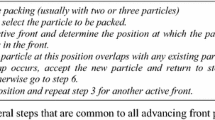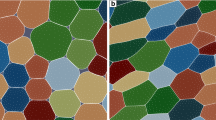Abstract
The discrete element method (DEM) is a numerical method that has achieved general acceptance as an alternative tool to model discontinuous media, with a wide range of practical applications. Given that spheres are not always a suitable shape for DEM simulations, other particle shapes need to be used. However, for shapes different from spheres, there are not many advancing front packing algorithms, which are, in many cases, the best algorithms that allow obtaining an appropriate initial set of particles for a DEM simulation. This lack of advancing front packing algorithms for shapes different from spheres is mostly due to the difficulty of solving the problem of placing a mobile particle in contact with other two (in 2D) or three (in 3D) particles. In this paper, a new method for solving the problem of the particle in contact is proposed, and it is compared with the well-established wrappers method. It is shown that the new proposed method is a promising alternative for spherocylinders. For other shapes the formulation of the new method is shown to be correct, but it was clearly outperformed by the wrappers method and the efficiency of the proposed formulation needs to be improved by optimizing the solution procedure.
















Similar content being viewed by others
References
DEM Solutions. Engineering with confidence (2014). http://www.dem-solutions.com. Accessed 14 July 2014
ITASCA Consulting Group, Inc. (2014) PFC general purpose distinct-element modeling framework. http://www.itascacg.com/software/pfc. Accessed 14 July 2014
Smilauer V, Catalano E, Chareyre B, Dorofenko S, Duriez J, Gladky A, Kozicki J, Modenese C, Scholtès L, Sibille L, Stránský J, Thoeni K (2010) Yade Documentation, 1st edn. The Yade Project
LIGGGHTS Open Source Discrete Element Method Particle Simulation Code. http://www.cfdem.com/liggghts-open-source-discrete-element-method-particle-simulation-code. Accessed Nov 2015
ESyS-Particle. https://launchpad.net/esys-particle. Accessed Nov 2015
Abraham CL, Maas SA, Weiss JA, Ellis BJ, Peters CL, Anderson AE (2013) A new discrete element analysis method for predicting hip joint contact stresses. J Biomech 46(6):1121–1127
Dang HK, Meguid MA (2013) An efficient finite-discrete element method for quasi-static nonlinear soil-structure interaction problems. Int J Numer Anal Methods Geomech 37(2):130–149
Hahn M, Bouriga M, Kröplin B-H, Wallmersperger T (2013) Life time prediction of metallic materials with the discrete-element-method. Comput Mater Sci 71:146–156
Hassanpour A, Pasha M, Susana L, Rahmanian N, Santomaso AC, Ghadiri M (2013) Analysis of seeded granulation in high shear granulators by discrete element method. Powder Technol 238:50–55
Li X, Yu H-S, Li X-S (2013) A virtual experiment technique on the elementary behaviour of granular materials with discrete element method. Int J Numer Anal Methods Geomech 37(1):75–96
Lim K-W, Andrade JE (2014) Granular element method for three-dimensional discrete element calculations. Int J Numer Anal Methods Geomech 38:167–188
Nakamura H, Fujii H, Watano S (2013) Scale-up of high shear mixer-granulator based on discrete element analysis. Powder Technol 236:149–156
Pennec F, Alzina A, Tessier-Doyen N, Nait-ali B, Mati-Baouche N, Baynast HD, Smith DS (2013) A combined finite-discrete element method for calculating the effective thermal conductivity of bio-aggregates based materials. Int J Heat Mass Transf 60:274–283
Bourrier F, Kneib F, Chareyre B, Fourcaud T (2013) Discrete modeling of granular soils reinforcement by plant roots. Ecol Eng 61(C):646–657
Catalano E, Chareyre B, Barthélémy E (2014) Pore-scale modeling of fluid-particles interaction and emerging poromechanical effects. Int J Numer Anal Methods Geomech 38:51–71
Duriez J, Darve F, Donzé FV (2013) Incrementally non-linear plasticity applied to rock joint modelling. Int J Numer Anal Methods Geomech 37:453–477
Epifancev K, Nikulin A, Kovshov S, Mozer S, Brigadnov I (2013) Modeling of peat mass process formation based on 3D analysis of the screw machine by the code yade. Am J Mech Eng 1:73–75
Grujicic M, Snipes JS, Ramaswami S, Yavari R (2013) Discrete element modeling and analysis of structural collapse/survivability of a building subjected to improvised explosive device (IED) attack. Adv Mater Sci Appl 2:9–24
Hadda N, Nicot F, Bourrier F, Sibille L, Radjai F, Darve F (2013) Micromechanical analysis of second order work in granular media. Granul Matter 15:221–235
Hilton JE, Tordesillas A (2013) Drag force on a spherical intruder in a granular bed at low froude number. Phys Rev E 88:062203
Lominé F, Scholtès L, Sibille L, Poullain P (2013) Modelling of fluid-solid interaction in granular media with coupled LB/DE methods: application to piping erosion. Int J Numer Anal Methods Geomech 37:577–596
Nicot F, Hadda N, Darve F (2013) Second-order work analysis for granular materials using a multiscale approach. Int J Numer Anal Methods Geomech 37(17):2987–3007
Nicot F, Hadda N, Guessasma M, Fortin J, Millet O (2013) On the definition of the stress tensor in granular media. Int J Solids Struct 50(14–15):2508–2517
Scholtès L, Donzé FV (2013) A DEM model for soft and hard rocks: role of grain interlocking on strength. J Mech Phys Solids 61:352–369
Thoeni K, Lambert C, Giacomini A, Sloan SW (2013) Discrete modelling of hexagonal wire meshes with a stochastically distorted contact model. Comput Geotech 49:158–169
Tran VDH, Meguid MA, Chouinard LE (2013) A finite-discrete element framework for the 3D modeling of geogrid-soil interaction under pullout loading conditions. Geotext Geomembr 37:1–9
Mohammadi S (2003) Discontinuum mechanics using finite and discrete elements. WIT Press, Southampton
Smilauer V, Catalano E, Chareyre B, Dorofenko S, Duriez J, Gladky A, Kozicki J, Modenese C, Scholtès L, Sibille L, Stránský J, Thoeni K (2010) Yade Reference Documentation. Yade Documentation, 1st edn. The Yade Project
Smilauer V, Gladky A, Kozicki J, Modenese C, Stránský J (2010) Yade using and programming. Yade Documentation, 1st edn. The Yade Project
Van Liedekerke P, Tijskens E, Dintwa E, Anthonis J, Ramon H (2006) A discrete element model for simulation of a spinning disc fertilizer spreader I. Single particle simulations. Powder Technol 170(2):71–85. doi:10.1016/j.powtec.2006.07.024
Han K, Feng YT, Owen DRJ (2006) Polygon-based contact resolution for superquadrics. Int J Numer Methods Eng 66:485–501. doi:10.1002/nme.1569
Pournin L (2005) On the behavior of spherical and non-spherical grain assemblies, its modeling and numerical simulation. Ph.D. thesis, École Polytechnique Fédérale de Lausanne, Lausanne
Cheng YF, Guo SJ, Lai HY (2000) Dynamic simulation of random packing of spherical particles. Powder Technol 107(1–2):123–130
Jia X, Williams RA (2001) A packing algorithm for particles of arbitrary shapes. Powder Technol 120(3):175–186
Han K, Feng YT, Owen DRJ (2005) Sphere packing with a geometric based compression algorithm. Powder Technol 155(1):33–41
Mueller GE (2005) Numerically packing spheres in cylinders. Powder Technol 159(2):105–110
Fraige FY, Langston PA, Chen GZ (2008) Distinct element modelling of cubic particle packing and flow. Powder Technol 186(3):224–240
Benabbou A, Borouchaki H, Laug P, Lu J (2010) Numerical modeling of nanostructured materials. Finite Elem Anal Des 46(1–2):165–180
Bagi K (2005) An algorithm to generate random dense arrangements for discrete element simulations of granular assemblies. Granul Matter 7:31–43
Feng YT, Han K, Owen DRJ (2002) An advancing front packing of polygons, ellipses and spheres. Paper presented at the discrete element methods, numerical modeling of discontinua, Santa Fe
Feng YT, Han K, Owen DRJ (2003) Filling domains with disks: an advancing front approach. Int J Numer Methods Eng 56:699–713. doi:10.1002/nme.583
Valera R, Morales I, Vanmaercke S, Morfa C, Cortés L, Casañas H-G (2015) Modified algorithm for generating high volume fraction sphere packings. Comput Part Mech 2(2):1–12. doi:10.1007/s40571-015-0045-8
Pérez Morales I, Roselló Valera R, Recarey Morfa C, Cerrolaza M (2011) Particle-packaging for computational modeling of bone. CMES: Comput Model Eng Sci 79(3):183–200
Pérez Morales I, Pérez Brito Y, Cerrolaza M, Recarey Morfa C (2010) Un Nuevo Método de Empaquetamiento de Partículas: Aplicaciones en el Modelado del Tejido óseo. Revista Internacional de Métodos Numéricos para Cálculo y Diseño en Ingeniería 26(4):305–315
Löhner R, Oñate E (2004) A general advancing front technique for filling space with arbitrary objects. Int J Numer Methods Eng 61:1977–1991. doi:10.1002/nme.1068
Weisstein EW (2015) Kepler Conjecture. Wolfram MathWorld. http://mathworld.wolfram.com/KeplerConjecture.html. Accessed Nov 2015
Weisstein EW (2015) Apollonius Circle. Wolfram MathWorld. http://mathworld.wolfram.com/KeplerConjecture.html. Accessed Nov 2015
Bagi K (2005) An algorithm to generate random dense arrangements for discrete element simulations of granular assemblies. Granul Matter 7:31–43. doi:10.1007/s10035-004-0187-5
Feng YT, Han K, Owen DRJ (2002) An advancing front packing of polygons, ellipses and spheres. In: Cook BK, Jensen RP (eds) Discrete element methods. Numerical modeling of discontinua, Santa Fe, Sept 23–25 2002. Geotechnical Special Publication. American Society of Civil Engineers, pp 93–98
Benabbou A, Borouchaki H, Laug P, Lu J (2009) Geometrical modeling of granular structures in two and three dimensions. Application to nanostructures. Int J Numer Methods Eng 80(4):425–454. doi:10.1002/nme.2644
Labra C, Oñate E (2008) High-density sphere packing for discrete element method simulations. Communications in Numerical Methods in Engineering. doi:10.1002/cnm.1193
Hernández Ortega JA (2003) Simulación numérica de procesos de llenado mediante elementos discretos. Polytechnic University of Catalonia
Pérez Morales I (2012) Método de Elementos Discretos: desarrollo de técnicas novedosas para la modelación con métodos de partículas. Universidad Central Marta Abreu de Las Villas, Santa Clara
Nelder JA, Mead R (1965) A simplex method for function minimization. Comput J 7:308–313
NLopt Algorithms (2015). http://ab-initio.mit.edu/wiki/index.php/NLopt_Algorithms#Nelder-Me...1. Accessed 21 July 2015
Hogue C (1998) Shape representation and contact detection for discrete element simulations of arbitrary geometries. Eng Comput 15(3):374–390
Sohn K-A, Juttler B, Kim M-S, Wang W (2002) Computing distances between surfaces using line geometry. Paper presented at the proceedings 10th Pacific conference on computer graphics and applications, 9–11 Oct 2002
Portal R, Sousa L, Dias J (2010) Contact detection between convex superquadric surfaces. Arch Mech Eng LVII 2:165–186. doi:10.2478/v10180-010-0009-8
Eberly D (2015) Geometric Tools. http://www.geometrictools.com/Documentation/Documentation.html. Accessed Nov 2015
Price K, Storn R (1997) Differential evolution: a simple evolution strategy for fast optimization. Dr Dobb’s J 264:18–24
Ingber L (1993) Simulated annealing: practice versus theory. Math Comput Model 18(11):29–57. doi:10.1016/0895-7177(93)90204-C
Acknowledgments
The authors are deeply grateful to the CAPES project 208/13.
Author information
Authors and Affiliations
Corresponding author
Electronic supplementary material
Below is the link to the electronic supplementary material.
Rights and permissions
About this article
Cite this article
Pérez Morales, I., Roselló Valera, R., Recarey Morfa, C. et al. Dense packing of general-shaped particles using a minimization technique. Comp. Part. Mech. 4, 165–179 (2017). https://doi.org/10.1007/s40571-016-0103-x
Received:
Revised:
Accepted:
Published:
Issue Date:
DOI: https://doi.org/10.1007/s40571-016-0103-x




